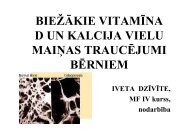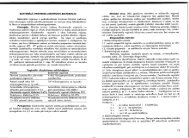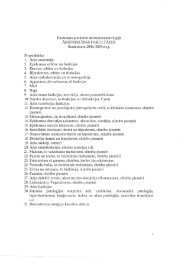PHYSICS
n - susliks.lv
n - susliks.lv
- No tags were found...
You also want an ePaper? Increase the reach of your titles
YUMPU automatically turns print PDFs into web optimized ePapers that Google loves.
tures mainly by moving into locations of favourable temperature<br />
(e.g., in the shade of a desert rock). Warm-blooded (homoiothermic)<br />
organisms normally keep practically constant body temperatures,<br />
independent of environment. Homoiothermic animals, including<br />
man, are able to control their body temperature not only<br />
by moving into favourable environments but also through internal<br />
regulatory effects on the nervous system modulating heat production<br />
and loss.<br />
A more recent and sensible terminology separates organisms<br />
into endotherms, who have a body temperature that is primarily<br />
dependent on internally generated metabolic heat, and ectotherms,<br />
who have a body temperature that is primarily dependent<br />
on external heat sources (the Sun or a heated substrate). These<br />
terms, therefore, emphasize the heat sources used, rather than<br />
the setting or constancy of achieved body temperature.<br />
There are dual setpoint regulatory systems in mammalian and<br />
reptilian nervous systems, with separate neural thermostats for<br />
controlling heat gain and heat loss. Some neurons ("warm receptors")<br />
increase pulse frequency when the hypothalamic temperature<br />
rises, and are probably linked to neurons that activate heat<br />
dissipation systems such as shade-seeking, sweating or vasodilation.<br />
Other neurons ("cold receptors") decrease in pulse frequency<br />
and may initiate vasoconstriction, basking and other behavioral<br />
effects. Still others only increase in pulse frequency when<br />
the hypothalamic temperature falls below a specific set-point;<br />
these are likely to trigger heat production mechanisms (i.e., shivering).<br />
13.2. HEAT PRODUCTION<br />
Vasoconstriction and vasodilation. Heat is produced in all body<br />
tissues, but particularly in the core organs of a resting animal and<br />
in muscles during activity. Heat must be distributed around the<br />
body, princi pally by the blood or other body fluids, and<br />
dissi pated at the surface according to need. The simplest form of<br />
thermal control is to manage the rate and volume of the flow of<br />
blood to the surface relative to the core. It is possible to<br />
distinguish vasoconstriction - the narrowing of surface blood<br />
vessels in response to cold temperature, keeping heat in the core<br />
96<br />
(fig. 13.1, a), and vasodilation - the expansion of a surface blood<br />
vessels in response to warm temperatures (fig. 13.1, b). For<br />
example, elephants use their large ears for thermoregulation, to<br />
cool themselves in the hot equatorial sun. As the elephant flaps its<br />
ears, blood vessels in the ear are cooled. The cooled blood circulates<br />
throughout the elephant and helps regulate overall body<br />
temperature. Another example, the fennec (Fennecus zerda) , is<br />
the smallest of the wild canid species. The fennec has incredibly<br />
large ears (fig. 13.2), which measure up to 15 ern in length,<br />
making it extremely sensitive to sound. It also assists in thermoregulation,<br />
which is essential in its North Africa desert habitat.<br />
Vasoconstriction<br />
Shunt vessels<br />
(A-V anastamoses)<br />
-+ Blood flow<br />
~ Heart transfer<br />
Low<br />
Surface conductance<br />
t<br />
t t Air<br />
vessels<br />
15°C or less<br />
Skin~<br />
a<br />
Vien<br />
High<br />
conductance<br />
I I I 35°C<br />
Vasodilation<br />
Fig. 13.1. Thermal regulation in animals:<br />
a through vasoconstriction - the narrowing of surface blood vessels<br />
in response to cold temperature and keeping heat in the core;<br />
b - through vasodilation - the expansion of a surface blood vessels<br />
in response to warm temperatures<br />
Huddling and aggregation. Endothermic animals in polar regions,<br />
such as penguins and some seals, cluster together when<br />
the temperature drops substantially (e.g., -50 0 q , typical in an<br />
Antarctic winter and when the wind speeds are over 160 kph.<br />
Penguins form much denser huddles than seals with up to<br />
b<br />
97






